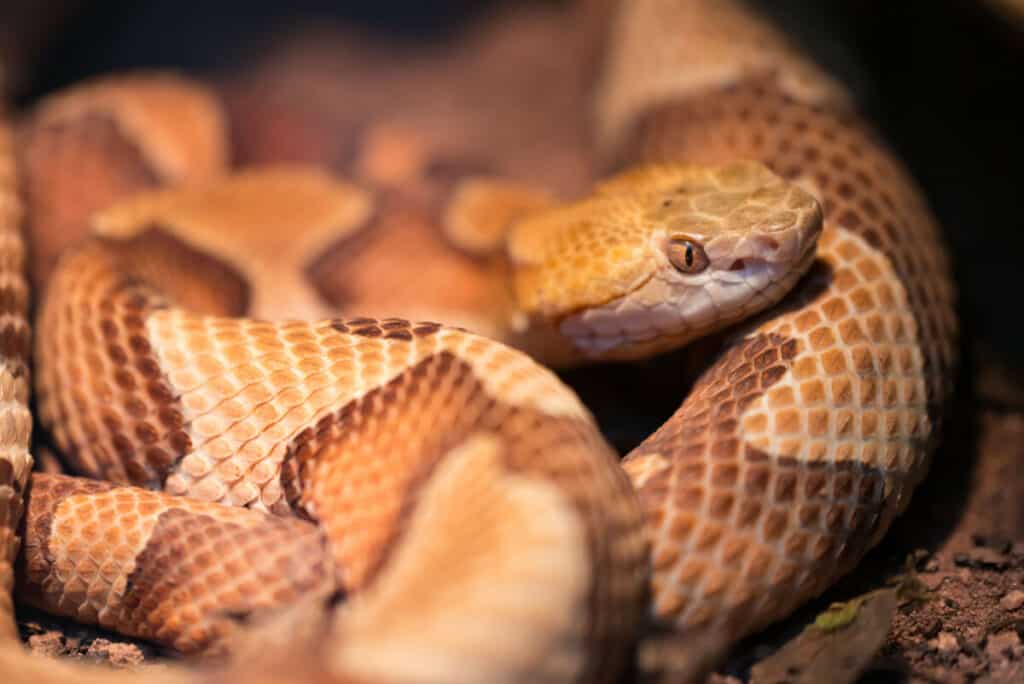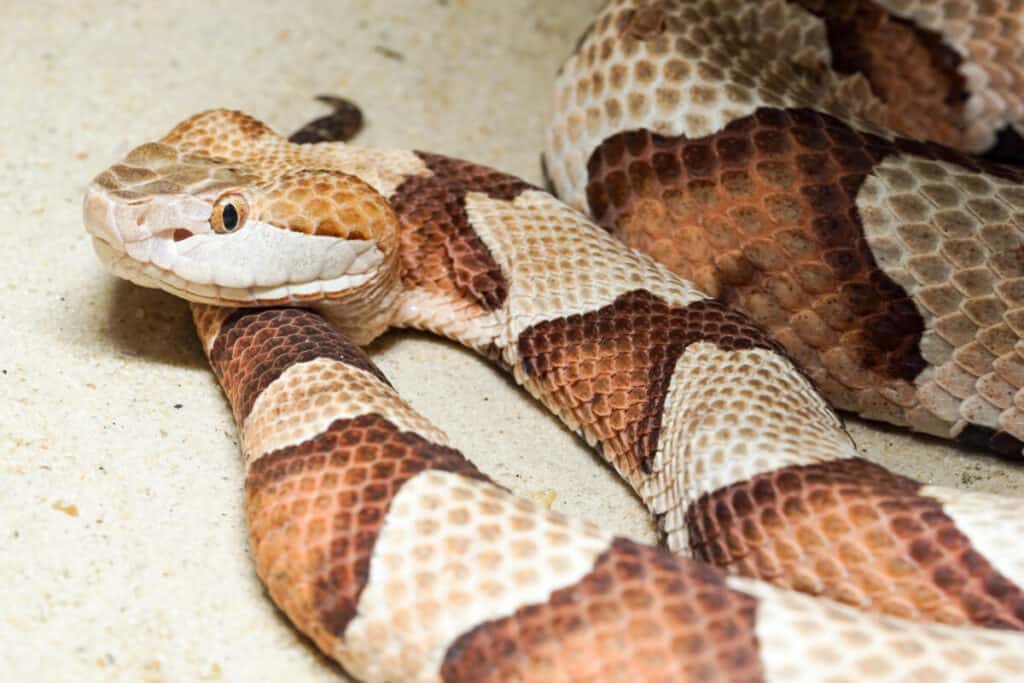
Summer is snake season, so let’s talk about copperheads. They’re nearly everywhere in the eastern United States, so exactly how worried should you be about getting bitten and just how venomous are copperhead snakes?
Copperheads are venomous, with their bites carrying a hemotoxin that causes swelling and damage to the surrounding tissue and the circulatory system. Some people are allergic to copperhead venom and have rapid reactions that can be fatal if not treated quickly enough.
Let’s go over just how venomous copperheads are, how aggressive they are, and how you can avoid getting bitten in the first place.
How Potent is Copperhead Venom?
When it comes to comparing it to other snakes, the copperhead is on the lower end of the toxicity spectrum. Copperhead venom has an LD50% value of 10.9 mg/kg. As a comparison, a Timber Rattlesnake’s LD50% value is 1.64 mg/kg. The unit LD50% (measured in mg/kg) is defined by how much of a toxin is enough to kill half of a population in a lab setting. (Source)
Of all the people bitten by copperheads in a year, only 0.01% of them end up dying. In addition to that, many copperhead bites are dry bites, meaning that the snake didn’t actually end up injecting any venom. These are “warning bites” to tell people to stay away. If it doesn’t cause an allergic reaction, dry bites are no worse than a puncture wound.
Of course, this does not mean you should not be careful. Copperhead snakes are still venomous snakes that can cause serious damage to humans. If you’re bitten you still need to make sure and get immediate medical attention. An allergic reaction to the bite could cause death by anaphylactic shock, and a bite where venom was injected can take several weeks to recover from even with treatment.
The best treatment is fast treatment, which can prevent further damage from happening. If left untreated, the venom will spread and cause damage to more areas of the body.
Usually, recovery is over within 2 to 4 weeks, but an untreated bite may take around 6 weeks to recover from. I don’t know about you, but I had to wear a finger cradle one time, and I was definitely sick of that by week 4, and that’s a lot less bothersome than restrictions you’d have to deal with from a copperhead bite. (Source)
Are Copperheads Aggressive and Dangerous?
Copperheads are venomous snakes but they are typically not very aggressive. However, they will bite if they feel threatened. Most snakes don’t like to be around humans, and copperheads are especially keen on avoiding human contact. Because of that, copperheads will only bite a person to protect themselves or their territory.
So if you encounter a copperhead out there, it’s not going to chase you down just to bite you. It’ll freeze in a strike position, it’ll make some noise with the leaves around it, and it may even give you a dry bite, but all of that is to warn you to leave it alone, not to start a fight.
A dangerous snake is one that kills a lot of people per year. Copperheads don’t even make the list. A bite from a copperhead is only very rarely fatal to a human, and those cases are either severe, untreated, or associated with an allergy. But again, you still need to be careful around any venomous snake. Most people who are bitten by copperheads were seen as a threat by the snake.
How to Avoid Getting Bitten by a Venomous Copperhead?
Copperheads want to avoid humans. They don’t see us as prey but as threats. Because of that, the best way to avoid a bite from a copperhead is to actively avoid the snake yourself.
When you’re out on a hike, wear thick hiking boots, stick to the established trails, and, most importantly, watch where you’re putting your feet. Thick boots will protect you from the worst of a bite aimed at your foot, which would probably be one of the worst places to get bitten on a hike where you might need to use your foot to get out and get help.
Sticking to clear, established trails will help you be able to easily spot any snakes in your path. Copperheads and other snakes are often very easy to miss among leaves, sticks, and other forest litter. They may also hide under logs or rocks for shade, and stepping on those rocks might disturb them.
Above all, watch where you’re going. The best way to avoid a snake bite is to see the snake before it’s a problem, and then carefully walk a different way. Once you know where the snake is, you should be able to pretty easily find a different path that won’t disturb it. If that’s not an option, you could also just back up and wait until it moves on.
Stay Alert If Copperheads Are Common Where You Live
If copperheads are common where you live, whether they frequent your backyard or your favorite outdoor spots, the same sort of things apply: stay alert and keep an eye out. When you spot a snake, give it a respectful amount of distance. It won’t bite you if you don’t make it feel threatened.
Like rattlesnakes, copperheads may wiggle their tails against leaf litter to bring attention to themselves. That’s them saying, “Hey, I’m here, don’t mess with me.” It’ll sound a little different from a rattlesnake, but whenever you hear that sound, stop and look where the sound is coming from to see where the snake is, then back away: you’re too close for the snake’s comfort.

What Snakes are Confused With Copperheads?
So far, we’ve been talking about copperheads in general, which have two specific subspecies. These snakes are distinguished by the copper color of their head. However, there are some other snakes that are colloquially called copperheads for a similar reason.
Other snakes that are called copperheads are water moccasins (also called cottonmouths), sharp-nosed pit vipers, and radiated rat snakes. These snakes have different venom levels from copperheads, especially water moccasins, which are very dangerous.
The way to tell whether the snake you’ve found is a true copperhead is by the pattern. The body of the copperhead is a light brown or orange color, banded with darker patches. They’re very loose shapes. From above, it might look like light diamonds running along the back, or dark triangles pointing into each other.
